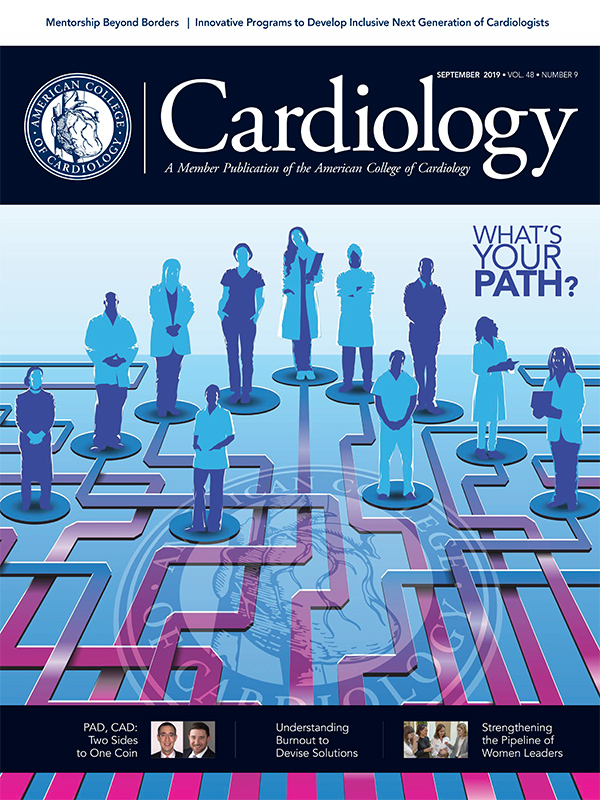Peripheral Matters | Peripheral and Coronary Artery Disease: Two Sides of the Same Coin

Coronary artery disease (CAD) remains the greatest cause of morbidity and mortality in the U.S. Upwards of 42 percent of patients with CAD also have peripheral artery disease (PAD).1,2 As PAD affects an estimated 200 million people worldwide, a substantial portion of the population has both conditions.
PAD is defined by the partial or complete obstruction of one or more of the peripheral arteries. Atherosclerotic disease remains one of the most common causes of PAD and therefore the primary therapeutic target.3 Identification of PAD can be made clinically, by history or physical exam, or based on subclinical identification of peripheral atherosclerotic disease on noninvasive modalities.
In asymptomatic individuals, the presence of arterial bruits, for example, has been linked with coronary heart disease.4 These peripheral manifestations of systemic atherosclerotic disease provide important prognostic clues on the burden of CAD and on subsequent adverse cardiovascular events.
Patients with PAD have a higher risk of subclinical CAD and are at higher risk of cardiovascular events when compared with healthy controls.5 Cardiovascular risk correlates to the severity of symptoms with asymptomatic individuals at lowest risk.6 PAD hospitalizations, as a potential marker of severity of PAD, have been linked to worse outcomes.7
The identification of symptomatic PAD has been associated with a 70 percent increased risk of cardiovascular events and 80 percent increased risk of death when compared with patients without PAD.7 In patients with clinically significant PAD (defined as an ankle-brachial index [ABI] <0.9), the prevalence of myocardial infarction (MI) is 2.5-times higher than in those patients without PAD.8 In patients with, vs. those without, acute coronary syndromes, prior history of cerebrovascular accident or transient ischemic attack, PAD is associated with worse outcomes and more extensive CAD.9
The presence of PAD also predicts more severe coronary disease, including left main CAD or complex CAD as quantified by a high SYNTAX score.10 Collectively, the severity of PAD correlates with both the development of and complications of CAD. The mechanism underpinning these observations is likely multifactorial.
The basis for the relationship of PAD to CAD and cardiovascular events may be defined by clinical overlap, with established atherosclerotic risk factors predicting the development of both PAD and CAD. These include male sex, age, diabetes, smoking, hypertension, hyperlipidemia and chronic kidney disease, among others.11
Beyond traditional risk factors, first-degree relatives of patients with PAD are at higher risk of subsequent PAD development and cardiovascular events, including stroke, MI or need for cardiac, lower extremity or carotid revascularization.5
This underscores a hereditary basis for atherosclerotic disease and highlights the multifactorial contributors to disease formation. The presence of PAD may relate to an overall higher burden of atherosclerotic disease, which leads to an increased risk profile that includes CAD.
Mitigating the effect of atherosclerotic disease following the identification of clinical or subclinical PAD centers on aggressive risk factor modification. Increased adverse cardiovascular outcomes in patients with PAD may in part be related to less aggressive treatment of risk factors upfront.9
Others, however, have noted that patients with concomitant PAD and CAD are more likely to be prescribed antiplatelet therapy, beta-blockers, ACE inhibitors and statins compared with patients with CAD alone.7 Yet, medical therapy alone does not attenuate the excess risk associated with PAD.7
Nonetheless, higher doses of statins and lower LDL-C levels are independently associated with improved outcomes in patients with PAD, suggesting value in risk factor-directed therapy, particularly in the absence of alternative strategies.12
It is conceivable that PAD is in fact a peripheral manifestation of already established substantive CAD, for which preventive therapies may offer less benefit.
Beyond overlapping risk factor profiles, PAD may independently drive adverse cardiovascular outcomes. Phenotypic differences in risk factor profiles are observed between PAD and CAD. PAD patients, for example, tend to have higher triglyceride levels and lower HDL-C.7 PAD may also lead to functional limitations in ambulation that may preclude exercise or activity known to be cardioprotective.
Furthermore, PAD patients are known to have abnormal peripheral vasodilation and paradoxical vasoconstriction in response to increased metabolic needs during stress. This failure of arterial vasodilation can lead to increased systemic afterload, which in turn impairs cardiac output and oxygen delivery.13
This mechanism is posited to contribute to some of the adverse cardiovascular outcomes associated with PAD. It also corroborates observations in patients with symptomatic PAD and cardiovascular events, who were more likely to have impaired flow-mediated vasodilation of the brachial artery.14
Collectively, the drivers of increased adverse cardiac events in PAD are likely a combination of overlapping direct and indirect causal factors related to the development of PAD and its hemodynamic sequelae.
Inflammatory markers (CRP, fibrinogen, IL-6, TNF-α) have also been identified as one of the strongest predictors of cardiovascular risk in patients with PAD and CAD.7,15 Specifically, CRP and the ratio of total cholesterol to HDL-C best predict the development of symptomatic PAD, with increasing CRP levels correlating to a higher risk of cardiovascular events and worse ABIs.16,17
The extent of systemic inflammation has also been correlated to severity of PAD.18 These observations are associated with similar observations in coronary heart disease, underscoring inflammatory drivers in the development of atherosclerotic disease and raising the prospect of modulation of inflammation in PAD and CAD as a therapeutic target.19,20 However, the clinical application and utility of inflammatory marker measurement and modulation remains to be seen.
PAD and CAD reflect overlapping disease states with suggestion of similar, albeit separate, underlying pathophysiologic mechanisms. Severity of symptomatic PAD correlates with cardiovascular outcomes. As contemporary understanding of atherosclerotic disease becomes more refined, the modulation of systemic inflammation will play an important role in advancing the therapeutic options of both disease states.
Until then, the most recent PAD guidelines center on aggressive risk factor modification, including the institution of antiplatelet therapy, lipid-lowering treatment, and optimization of glycemic and blood pressure control in patients with PAD, with the strongest level of recommendation directed at symptomatic patients.21
References
- Hiatt WR, Goldstone J, Smith SC Jr., et al. Atherosclerotic Peripheral Vascular Disease Symposium II: nomenclature for vascular diseases. Circulation 2008;118:2826-9.
- Poredos P, Jug B. The prevalence of peripheral arterial disease in high risk subjects and coronary or cerebrovascular patients. Angiology 2007:58:309-15.
- Song P, Rudan D, Zhu Y, et al. Global, regional, and national prevalence and risk factors for peripheral artery disease in 2015: an updated systematic review and analysis. Lancet Glob Health 2019;7:e1020-30.
- Brand FN, Kannel WB, Evans J, et al. Glucose intolerance, physical signs of peripheral artery disease, and risk of cardiovascular events: the Framingham Study. Am Heart J 1998:136:919-27.
- Valentine RJ, Verstraete R, Clagett GP, Cohen JC. Premature cardiovascular disease is common in relatives of patients with premature peripheral atherosclerosis. Arch Intern Med 2000;160:1343-8.
- Criqui MH, Langer RD, Fronek A, et al. Mortality over a period of 10 years in patients with peripheral arterial disease. N Engl J Med 1992:326:381-6.
- Grenon SM, Vittinghoff E, Owens CD, et al. Peripheral artery disease and risk of cardiovascular events in patients with coronary artery disease: insights from the Heart and Soul Study. Vasc Med 2013;18:176-84.
- Newman AB, Siscovick DS, Manolio TA, et al. Ankle-arm index as a marker of atherosclerosis in the Cardiovascular Health Study. Cardiovascular Heart Study (CHS) Collaborative Research Group. Circulation 1993:88:837-45.
- Cotter G, Cannon CP, McCabe CH, et al. Prior peripheral arterial disease and cerebrovascular disease are independent predictors of adverse outcome in patients with acute coronary syndromes: are we doing enough? Results from the Orbofiban in Patients with Unstable Coronary Syndromes-Thrombolysis In Myocardial Infarction (OPUS-TIMI) 16 study. Am Heart J 2003;145:622-7.
- Kim EK, Song PS, Yang JH, et al. Peripheral artery disease in korean patients undergoing percutaneous coronary intervention: prevalence and association with coronary artery disease severity. J Korean Med Sci 2013;28:87-92.
- Gardner AW, Afaq A. Management of lower extremity peripheral arterial disease. J Cardiopulm Rehabil Prev 2008;28:349-57.
- Feringa HH, Karagiannis SE, van Waning VH, et al. The effect of intensified lipid-lowering therapy on long-term prognosis in patients with peripheral arterial disease. J Vasc Surg 2007;45:936-43.
- Golomb BA, Dang TT, Criqui MH. Peripheral arterial disease: morbidity and mortality implications. Circulation 2006;114:688-99.
- Pasqualini L, Marchesi S, Vaudo G, et al. Association between endothelial dysfunction and major cardiovascular events in peripheral arterial disease. Vasa 2003;32:139-43.
- Tzoulaki I, Murray GD, Lee AJ, et al. C-reactive protein, interleukin-6, and soluble adhesion molecules as predictors of progressive peripheral atherosclerosis in the general population: Edinburgh Artery Study. Circulation 2005;112:976-83.
- Ridker PM, Stampfer MJ, Rifai N. Novel risk factors for systemic atherosclerosis: a comparison of C-reactive protein, fibrinogen, homocysteine, lipoprotein(a), and standard cholesterol screening as predictors of peripheral arterial disease. JAMA 2001;285:2481-5.
- Beckman JA, Preis O, Ridker PM, Gerhard-Herman M. Comparison of usefulness of inflammatory markers in patients with versus without peripheral arterial disease in predicting adverse cardiovascular outcomes (myocardial infarction, stroke, and death). Am J Cardiol 2005;96:1374-8.
- Cauley JA, Kassem AM, Lane NE, et al. Prevalent peripheral arterial disease and inflammatory burden. BMC Geriatr 2016;16:213.
- Danesh J, Wheeler JG, Hirschfield GM, et al. C-reactive protein and other circulating markers of inflammation in the prediction of coronary heart disease. N Engl J Med 2004;350:1387-97.
- Ridker PM, Everett BM, Thuren T, et al. Antiinflammatory therapy with canakinumab for atherosclerotic disease. N Engl J Med 2017;377:1119-31.
- Gerhard-Herman MD, Gornik HL, Barrett C, et al. 2016 AHA/ACC guideline on the management of patients with lower extremity peripheral artery disease: executive summary: a report of the American College of Cardiology/American Heart Association Task Force on Clinical Practice Guidelines. J Am Coll Cardiol 2017;69:1465-1508.
Clinical Topics: Acute Coronary Syndromes, Diabetes and Cardiometabolic Disease, Dyslipidemia, Heart Failure and Cardiomyopathies, Prevention, Vascular Medicine, Atherosclerotic Disease (CAD/PAD), ACS and Cardiac Biomarkers, Hypertriglyceridemia, Lipid Metabolism, Nonstatins, Novel Agents, Statins, Heart Failure and Cardiac Biomarkers, Hypertension, Smoking
Keywords: ACC Publications, Cardiology Magazine, Ankle Brachial Index, Ischemic Attack, Transient, Risk Factors, Peripheral Arterial Disease, Hydroxymethylglutaryl-CoA Reductase Inhibitors, Angiotensin-Converting Enzyme Inhibitors, Brachial Artery, Vasodilation, Blood Pressure, Prevalence, Acute Coronary Syndrome, Interleukin-6, Vasoconstriction, Vasoconstriction, Fibrinogen, Prognosis, Cardiovascular Diseases, Coronary Vessels, Myocardial Infarction, Stroke, Hypertension, Lower Extremity, Morbidity, Cardiac Output, Coronary Disease, Hyperlipidemias, Diabetes Mellitus, Renal Insufficiency, Chronic, Smoking, Hospitalization, Inflammation, Lipids, Triglycerides, Cholesterol, Oxygen
< Back to Listings



